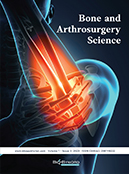Abstract
Purpose: To explore the clinical effects of the direct anterior approach (DAA) and the direct lateral approach in elderly patients with irreducible intertrochanteric fractures. Methods: A retrospective analysis method was used to collect samples of 18 elderly patients with irreducible intertrochanteric fractures of the femur admitted to our hospital from January 2020 to January 2023, and they were divided into a study group (n = 9) and a control group (n = 9) according to different surgical plans. Both groups of patients underwent internal fixation with proximal femoral nail anti-rotation (PFNA). The patients in the control group were treated through the direct lateral approach, and those in the study group were treated using DAA. The surgical conditions, recovery conditions, and indicators of postoperative complications were compared between the two groups. Results: The operation time and intraoperative blood loss of the study group were lower than that of the control group (P < 0.05); there was no significant difference in the degree of hip flexion and extension recovery between the two groups after surgery, as well as the functional scores (P > 0.05); the study group had a lower incidence of complication than the control group (P < 0.05). Conclusion: Compared with the direct lateral approach, the DAA to the hip joint in elderly patients with irreducible intertrochanteric fractures can shorten the operation time, reduce intraoperative blood loss, and shorten the recovery period of joint function. With a satisfactory prognosis and low incidence of complications, it can be promoted and applied in medical institutions.
References
Zhao H, Deng X, Liu W, et al., 2023, Proximal Femoral Bionic Nail (PFBN) – An Innovative Surgical Method for Unstable Femoral Intertrochanteric Fractures. International Orthopaedics (SICOT), 2023(47): 1089–1099.
Avinash K, Deepak CD, 2021, Comparative Study Between Proximal Femoral Nailing and Dynamic Hip Screw in Management of Intertrochanteric Fracture of Femur. International Journal of Orthopaedics Sciences, 7(3): 520–522.
Rajak MK, Kumar S, Thakur R, et al., 2021, A Rare Case of Simultaneous Fracture Neck of Femur on One Side and Contralateral Intertrochanteric Fracture Femur in a 41-Year-Old Female – A Case Report. Journal of Orthopaedic Case Reports, 11(7): 61–64.
Khader FA, Varman M, Krishna RJ, 2021, Prospective and Comparative Study of Functional Outcome of Intertrochanteric Fracture of Femur Treated with Dynamic Hip Screw (VS) Proximal Femoral Nail. International Journal of Orthopaedics Sciences, 7(1): 222–226.
Nguyen AS, Onizuka N, Switzer JA, 2022, Medial Femoral Circumflex Artery Pseudoaneurysm Following Intramedullary Nailing for Intertrochanteric Fracture. Trauma Case Reports, 2022(37): 100577.
Rougereau G, Naline C, Boisrenoult P, et al., 2023, Proximal Femoral Fracture and Female Gender are Risk Factors for Recurrent Fracture: Cohort Study of 292 Patients Over 75 Years-Old with Iterative Osteoporotic Fractures. Injury, 54(6): 1716–1720.
Hassim MHM, Bahaudin N, Rahman ZA, et al., 2022, Irreducible Posterior Hip Dislocation with Associated Isolated Comminuted Greater Trochanter Avulsion Fracture Treated with Universal Locking Trochanteric Stabilization Plate: A Rare Combination of Hip Injury. Open Journal of Orthopedics, 12(2): 9.
Ye Y, Zhao B, Chen D, et al., 2019, Comparative Analysis of Posterosuperior Minimally Invasive Approach and Posterolateral Approach in Femoral Head Replacement for Intertrochanteric Fracture. Guizhou Medicine, 43(9): 1427–1428.
He W, Yi C, 2023, A Case of Guide Pin Breakage During PFNA Internal Fixation of Femoral Intertrochanteric Fracture Assisted by DAA Approach. Chinese Journal of Bone and Joint Injury, 38(6): 659–660.
Zhou QJ, Peng XQ, Fei ZG, et al., 2021, Treatment of Nonunion After Femoral Neck Fracture with Valgus Intertrochanteric Osteotomy: A Case Report with 18-Year Follow-Up. The Journal of International Medical Research, 49(5): 1–8.
Zhong G, Teng L, Li H, et al., 2012, Surgical Treatment of Internal Fixation Failure of Femoral Peritrochanteric Fracture. Orthopaedic Surgery, 13(6): 1739–1747.
Zheng L, Wong WC, Chen X, et al., 2022, Risk of Proximal Femoral Nail Antirotation (PFNA) Implant Failure Upon Different Lateral Femoral Wall Thickness in Intertrochanteric Fracture: A Finite Element Analysis. Computer Methods in Biomechanics and Biomedical Engineering, 25(5): 512–520. http://doi.org/10.1080/10255842.2021.1964488
Li X, 2020, Effects of Ultrasound-Guided Sciatic Nerve Block Combined with General Anesthesia on Propofol Dosage and Postoperative Effects in Patients with Intertrochanteric Fractures. Journal of Practical Medicine, 37(4): 340–342.
Zhou M, Chen Y, Qian J, et al., 2022, Treatment of Coronal Plane Femoral Intertrochanteric Fractures with a Microexternal Fixator Combined with Proximal Femoral Nail Antirotation. Journal of Healthcare Engineering, 2022: 1735603.
Yee KH, Wong JSH, Fang E, et al., 2022, Topical Administration of Tranexamic Acid in Elderly Patients Undergoing Short Femoral Nailing for Intertrochanteric Fracture: A Randomized Controlled Trial. Injury, 53(2): 603–609.
